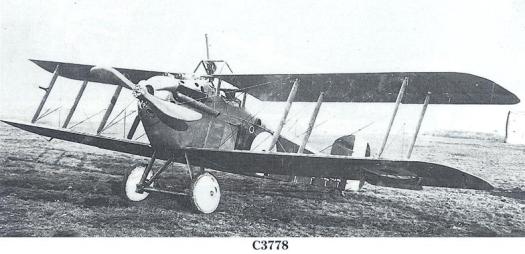Among the several undated and unmarked photographs in Greg’s collection is an aerial image with the title “A British Aerodrome”. For a while, the location of the subject of the photograph proved a puzzle. But thanks to Great War Forum user Roger Austin, who consulted Jacques Calcine of Anciens Aerodromes, it has now been identified as Flixecourt, which is some 13 miles (20 km) northwest of Amiens, in the Somme valley. But that identification has led to another puzzle: there is no record of an aerodrome at Flixecourt, British or otherwise. And Greg didn’t fly around there. So what’s going on?
“A British Aerodrome”
Here the photograph in question, titled in an album in what looks like Greg’s writing.

And here is the equivalent view on Google maps today:

The original photograph is technically a high-angle, oblique aerial view. “Oblique” because it is not looking straight down at the ground. And “high angle” because the angle of the camera is high enough for the horizon to be visible. The equivalent Google maps image looks rather flattened, again because of the high angle, and because Google’s imagery is not 3D in that part of France.
Flixecourt

Flixecourt lies about 13 miles (20 km) northwest of Amiens along the Somme valley, halfway towards Abbeville. It is on a small stream – La Nièvre – about 1½ miles (2.5 km) before it flows into the Somme. Flixecourt’s principal industry was jute weaving, which was the business of the Saint Frères factory in the centre of the photograph , whose proprietors lived in the ornate Château de Flixecourt on the right. The factory is now part of RKW Group and makes films for consumer and industrial packaging.
What was the Date of the Original Photograph?
It was evidently taken on a sunny day, and the trees look as if they are in full foliage. The shadows, where visible, are quite short. (See for example the shadow of the short bush in the sparse trees in the bottom central section.) So it’s likely that the photo dates from the summer months. And the only summer Greg was in France for was that of 1918.
Is There an Aerodrome in the Photograph?
That’s a good question, particularly as there is no other record of a British Aerodrome at Flixecourt.
All the land in the distance, above the factory, seems to be farmland. The only real candidate for an aerodrome is on the centre left of the image. This the area is to the left of the chimneys and above the buildings. The present day Google maps image shows it still to be an area of open ground. Interestingly, the dimensions of the open ground today are about 1,500 ft x 1,500 ft (450m x 450 m), which makes it just about large enough to be useful as a landing ground for First World War aircraft.
Landing Grounds
Wikipedia has this to say about Royal Flying Corps landing grounds:
Landing Grounds were often L-shaped, usually arrived at by removing a hedge boundary between two fields, and thereby allowing landing runs in two directions of 400–500 metres (1,300–1,600 ft). Typically they would be manned by only two or three airmen, whose job was to guard the fuel stores and assist any aircraft which had occasion to land. Accommodation for airmen and pilots was often in tents, especially on the Western Front. Officers would be billeted to local country houses, or commandeered châteaux when posted abroad, if suitable accommodation had not been built on the Station.
Landing Grounds were categorised according to their lighting and day or night capabilities:
-
First Class Landing Ground – Several buildings, hangars and accommodation.
-
Second Class Landing Ground – a permanent hangar, and a few huts.
-
Third Class Landing Ground – a temporary Bessonneau hangar
-
Emergency (or Relief) Landing Ground – often just a field, activated by telephone call to the farmer, requesting he move any grazing animals out.
-
Night Landing Grounds would be lit around the perimeter with gas lights and might have a flarepath laid out in nearby fields. [https://en.wikipedia.org/wiki/Royal_Flying_Corps]
So it is physically possible that there was an aerodrome or landing ground at the centre left.
Why Might There Have Been an Aerodrome at Flixecourt?
The Château de Flixecourt had some interesting associations with the British military in the First World War. In 1916 is was home to the Fourth Army School, attended by Siegfried Sassoon among others. More significant for our purposes was the use of the château in the summer of 1918. From 5 April to 29 August 1918 it was the headquarters of the Fourth Army, which was under the command of General Sir Henry Rawlinson. And it was from here on 8 August 1918 that Rawlinson launched the Battle of Amiens. This was the battle that marked the start of the allies’ final offensive:
The ‘Black Day’ that Marked the Start of the Last Hundred Days
A Busy Time at Flixecourt
Thus began ‘The Last Hundred Days’. Flixecourt must have been a busy place at the time. And even though the offensive was strategically halted – or at least paused – on 11 August 1918, the following day saw another significant event: a visit by King George V.

Left to right, front row – General Henry Rawlinson; unknown; General Maxime Weygand (in the second row); Marshal Ferdinand Foch; King George V; Field Marshal Douglas Haig; Marshal Philippe Pétain; unknown. Click for larger image. Copyright: © IWM. Original Source: http://www.iwm.org.uk/collections/item/object/205245028
So, with these momentous events taking place at the Château de Flixecourt in August 1918, it isn’t beyond the bounds of possibility that there was temporary landing ground for aircraft close by. As Great War Forum user Regulus 1 has pointed out, given the proximity to Fourth Army HQ it would be logical. Maybe some visitors were ferried in by air. Although given the risky nature of flying, perhaps not too important ones! Or maybe planes carried messages too sensitive for the telephone and too urgent for despatch rider. And if the landing ground was only temporary, that could explain why we don’t see references to it as an established aerodrome. Except of course in the caption to the photograph.
And the Photographer was…
…almost certainly not Greg. There is no record of Greg flying in the Somme sector. 42 Squadron RAF operated along the River Lys, and then the River Scheldt (or Escaut). And if the photo was taken in early to mid-August, as speculated above, we know that Greg was busy with artillery shoots and counter-battery patrols around Merville, on the Lys, at the time.
Nonetheless, Greg did have some aerial photos from the Somme area. Photographs of Bray-sur-Somme and Mametz from 205 Squadron RAF, and of Cantigny from Escadrille SPA.42 have already been published on the blog – see https://gregswar.com/tag/somme/. Maybe this photo came from the same source.
An Alternative Theory
Alternatively, a less poetic but certainly plausible theory is that someone mislabelled the photograph. Maybe this was because it was given to Greg and misidentified or misunderstood to be showing an aerodrome. Perhaps Greg made a mistake, or perhaps the donor did.
Does anyone have any further evidence, either way? Please get in touch via the Contact page if so, or by commenting on this post.



















 Warbird Tails
Warbird Tails 















